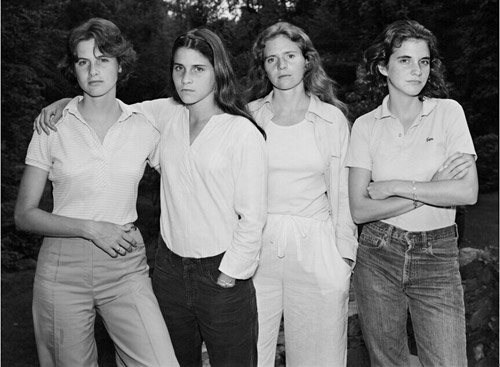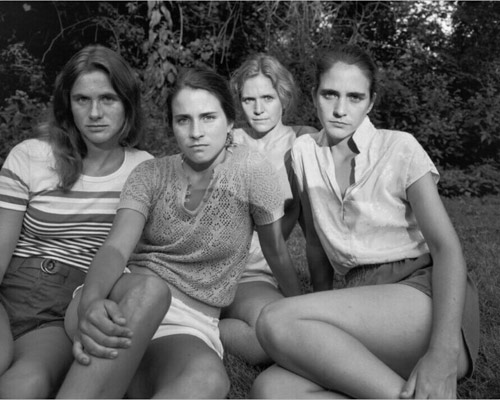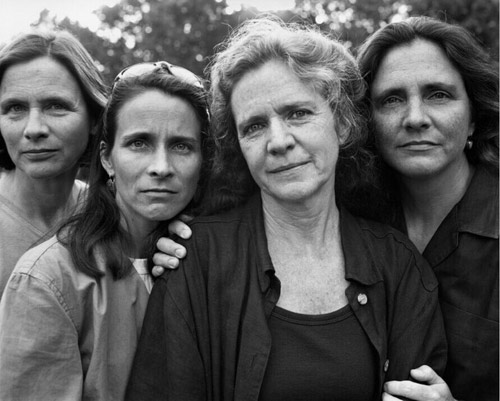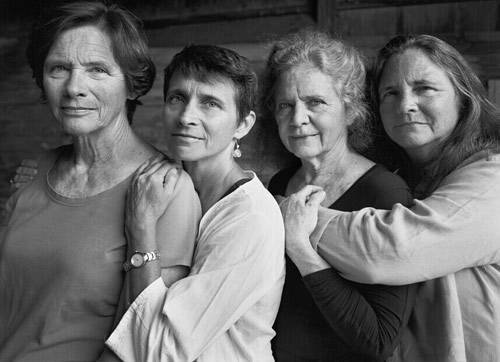当前位置: Language Tips> 英语学习专栏
一切都起源于摄影师尼古拉斯的“心血来潮”,从1975年开始,他为布朗四姐妹每年拍一幅合影,至今已经有40年!请看下面由照片记录的光阴故事。




By Susan Minot
思含 选 祝平 注
Nicholas Nixon was visiting his wife’s family when, “on a whim ,” he said, he asked her and her three sisters if he could take their picture. It was summer 1975, and a black-and-white photograph of four young women—elbows casually attenuated, in summer shirts and pants, standing pale and luminous against a velvety background of trees and lawn—was the result. A year later, at the graduation of one of the sisters, while readying a shot of them, he suggested they line up in the same order. After he saw the image, he asked them if they might do it every year. “They seemed O.K. with it,” he said; thus began a project that has spanned almost his whole career. The series, which has been shown around the world over the past four decades, was on view at the Museum of Modern Art, coinciding with the museum’s publication of the book The Brown Sisters: Forty Years in November, 2014.
Who are these sisters? We’re never told (though we know their names: from left, Heather, Mimi, Bebe and Laurie; Bebe, of the penetrating gaze, is Nixon’s wife). The human impulse is to look for clues, but soon we dispense with our anthropological scrutiny—Irish? Yankee, quite likely, with their decidedly glamour-neutral attitudes—and our curiosity becomes piqued instead by their undaunted stares. All four sisters almost always look directly at the camera, as if to make contact, even if their gazes are guarded or restrained.
Whenever a woman is photographed, the issue of her vanity is inevitably raised, but Nixon has finessed this with his choice of natural light, casual manner and unfussy preparation. The sisters never discuss what they are going to wear. Bebe Nixon says simply: “We just wear what we feel like wearing that day.”
Throughout this series, we watch these women age, undergoing life’s most humbling experience. While many of us can, when pressed, name things we are grateful to time for bestowing upon us, the lines bracketing our mouths and the loosening of our skin are not among them. So while a part of the spirit sinks at the slow appearance of these women’s jowls, another part is lifted: They are not undone by it. We detect more sorrow, perhaps, in the eyes, more weight in the once-fresh brows. But the more we study the images, the more we see that aging does not define these women. Even as the images tell us, in no uncertain terms, that this is what it looks like to grow old, this is the irrefutable truth, we also learn: This is what endurance looks like.
It is the endurance of sisterhood in particular. Nixon, who grew up a single child, says he has always been particularly intrigued by the sisterly unit, and it shows in these images. With each passing year, the sisters seem to present more of a united front. Earlier assertions of their individuality—the arms folded across the chest, the standing apart—give way to a leaning on one another, as if independence is no longer such a concern. We see what goes on between the sisters in their bodies, particularly their limbs . A hand clasps a sister’s waist, arms embrace arms or are slung in casual solidarity over a shoulder. A palm steadies another’s neck, reassuring. The cumulative effect is dizzying and powerful. When 36 prints were exhibited in a gallery in Granada, Spain, viewers openly wept.
The deepening of the sisters’ relationships extends to the one with Nixon. Each sister has always had the opportunity to weigh in on the annual selection of which shot would represent that year, but in the past 10 years, the process has become much more collaborative. Once, when the sisters were unanimous in a choice that wasn’t the same as Nixon’s, he bowed to their wish. “I have to be fair here,” he said. When his own shadow first appears, falling across the faces—in ’81, ’83 and ’84—alongside the square of his 8-by-10 camera, you can feel him angling to join in, to be part of the group himself. But in later years, the collaborative bond between him and his subjects shows. The women’s eyes now seem to regard the photographer with a glow of trust and sisterly affection. “We’ve gotten close,” Nixon acknowledges.
As we come to the last pictures, we feel the final inevitability that, as Nixon says, “Everyone won’t be here forever.” The implication hovers in the darkening of the palette and in the figures drawing together, huddling as if to stay afloat. To watch a person change over time can trick us into thinking we share an intimacy, and yet somehow we don’t believe that these poses and expressions are the final reflection of the Brown sisters. The sisters allow us to observe them, but we are not allowed in. The reluctance shows particularly in the early pictures: the wary lowered brow, the pressed line of a mouth. Sometimes a body’s stance or the angle of the jaw is downright grudging. These subjects are not after attention, a rare quality in this age when everyone is not only a photographer but often his own favorite subject. In this, Nixon has pulled off a paradox: The creation of photographs in which privacy is also the subject. The sisters’ privacy has remained of utmost concern to the artist, and it shows in the work. Year after year, up to the last stunning shot with its triumphant shadowy mood, their faces and stances say, Yes, we will give you our image, but nothing else.
Vocabulary
1. on a whim: 一时兴起。
2. 这是1975年的夏天,她们身着夏季衣裤站在那里,露出纤细的肘部,在身后的树木和草地作为背景的映衬下,她们的脸苍白而又发亮——一张四位女性的黑白照片就这样诞生了。elbow: 肘部;attenuate: 变纤细;luminous: 发光的;velvety: 天鹅绒般柔软的。
3. span: 跨越,持续。
4. coincide with: 与……一致。
5. penetrating: 有洞察力的。
6. impulse: 冲动;dispense with: 省掉;anthropological: 人类学的;scrutiny: 详细审查。 7. Yankee: 美国人;glamour-neutral: 中性魅力的;piqued: 被触怒的;被惹恼的;undaunted: 勇敢的,无畏的。
8. 当一位女性被拍时,她免不了会虚荣心上涨,但是尼克松巧妙地处理了这一点——运用自然的光线,平常的态度和随意的准备。finesse: 巧妙处理;natural light: 自然光;unfussy: 不小题大做的。
9. 我们当中的很多人,如果不得不说的话,也能列举出几个时光所赋予我们的美好事物,不过嘴角的纹路和松弛的皮肤不在此列。bestow upon: 赠与;bracket: v.(两个东西)分别位于…的两面,此处指长在嘴角的皱纹。
10. jowl: 面颊;undo: 破坏,扰乱。
11. 我们看到她们眼中蕴含了更多的忧伤,曾经年轻的眉宇间透露着更多的沉重。detect: 察觉,发现。
12. irrefutable: 无可辩驳的;endurance: 耐力,持久性。
13. intrigue: 引起……的兴趣。
14. 早年对于自己个性的坚持——在胸前环抱着双臂,分开站立的姿势——现在已经变成了对彼此的依靠,独立似乎已经不再是个重点。
15. limbs: 手脚,四肢。
16. clasp: 扣住,紧握;slung: 是sling的过去分词,sling sth. over sth.: 把……搭在……上;solidarity: 团结。
17. cumulative: 累积的;dizzying: 令人激动的。
18. weigh in: 参加讨论;collaborative: 合作的,协作的。
19. unanimous: 意见一致的;bow to: 顺从。
20. angle to do sth.: 谋求做某事。
21. hover: 盘旋;palette: 主色调;huddle: 挤作一团;stay afloat: 维持下去。
22. trick sb. into doing: 欺骗某人做某事;intimacy: 亲密。
23. reluctance: 不情愿;wary: 警惕的,小心翼翼的。
24. stance: 姿势,姿态; angle of the jaw: 下颌角;downright: 彻底地,完全地;grudging: 不情愿的,勉强的。
25. 在照片中,尼克松运用了一个悖论:摄影作品中,隐私同样也是主题。pull off: 努力实现。 26. 年复一年,直至最后的一个精彩镜头,她们的面庞和姿势洋溢着成功的喜悦:“是的,我们留下的只是影像,这就是全部。”stunning: 极好的;triumphant: 得意洋洋的,成功的;shadowy: 模糊的,朦胧的。
(来源:英语学习杂志 编辑:丹妮)
上一篇 : 最离谱的请假借口
下一篇 :
关注和订阅


电话:8610-84883645
传真:8610-84883500
Email: languagetips@chinadaily.com.cn